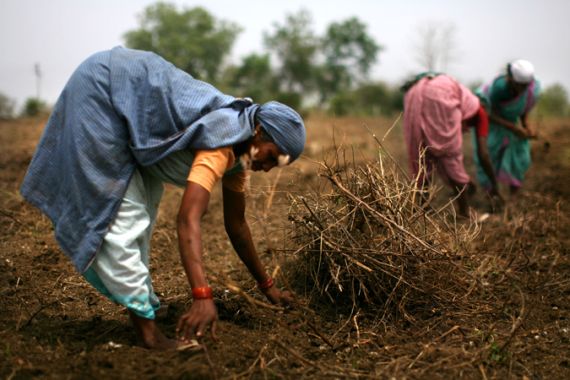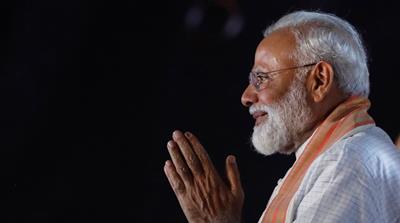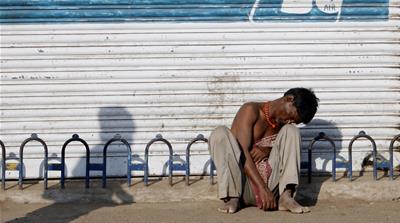Life after demonetisation: How India’s poor are paying the price
More than two years on, many of India’s poor are still dealing with the effects of PM Narendra Modi’s financial reforms.

New Delhi, India – It was nearly midday on a recent morning, and Anil Pradhan was tending to his stall in what was once a busy vegetable market on the outskirts of India‘s capital, New Delhi, wondering whether he should pack up for the day. He hadn’t made a sale in hours.
The 55-year-old vendor’s small business survived Prime Minister Narendra Modi’s move to ban large denomination currency notes in 2016 and the imposition of a goods and services tax (GST) the following year. But he and his fellow traders are hardly thriving.
Keep reading
list of 4 itemsThirty years waiting for a house: South Africa’s ‘backyard’ dwellers
Photos: Malnutrition threatens future Afghan generations
From prisoner to president in 20 days, Senegal’s Diomaye Faye takes office
“Ever since demonetisation, business has been so bad that half the vendors in the market have shut shop,” Pradhan told Al Jazeera. “This market hardly gets customer traffic after 11am these days. Having made money from this small business for the past 35 years, I may have to shut down, too.”
Pradhan is one of the millions of people in India who work without a formal employment contract, making up the so-called informal economy. The International Labour Organization estimates that more than eight out of 10 people who are not employed in agriculture work in the informal economy.
Analysts say Modi’s financial reforms hit people in the informal sector – who are also among India’s poorest – particularly hard. Ironically, the poor were also among his main campaign targets in the country’s recent general elections, which his Bharatiya Janata Party (BJP) won decisively.
“Most commentators failed to notice that the BJP and the Indian bureaucracy almost flawlessly delivered on a number of initiatives that make the life of the poor and vulnerable better,” Kunjal Gala, co-portfolio manager at Hermes Investment Management, said in a research note.
Some of those initiatives included universal access to bank accounts, the provision of cooking gas and sanitation facilities, and rural electrification programmes.
Supporters of demonetisation and the GST say the reforms are helping to reduce corruption and will benefit the economy in the long term.
‘No silver lining’
But try telling that to businesspeople like Mujeeb Rahman, the 47-year-old owner of a plywood factory in the town of Perumbavoor in the southern state of Kerala, about 3,000km from New Delhi. He says he sees no “silver lining on the horizon”.
“The small businesses here are in shambles and struggling to stay afloat,” Rehman told Al Jazeera.

“The first blow was dealt by the demonetisation cash crunch that jolted the construction sector, the biggest customer for my business. But the death knell was driven by the Goods and Services Tax, which crippled all construction activities in the region. My revenue has halved over the past two years, and the foreseeable future looks hopeless,” he said.
Modi’s government surprised India and the rest of the world on November 8, 2016, when it announced that 500-rupee ($7.2) and 1,000-rupee ($14.3) notes would no longer be legal tender. More than $206bn worth of cash was effectively removed from circulation, or about 86 percent of the total. Authorities eventually replaced the older notes with new ones, but their production and distribution were slow, resulting in a cash squeeze and chaos.
‘A more tax-compliant society’
Former Finance Minister Arun Jaitley said in a Facebook post on October 1, 2016 that “The object of the scheme was to try and make India a more tax compliant society. Tax compliance leads to higher revenues, reduction of budget deficits and money collected is spent on infrastructure, social-sector and the rural areas. This benefits India’s poor.”
But the government’s latest budget projects that its deficit will increase both in actual monetary terms and as a percentage of the size of the Indian economy.
And just as Indians were recovering from demonetisation, the government implemented the GST in July 2017, something that Gautam Chikermane, an economist and vice president of the Observer Research Foundation, an economic think-tank, describes as the “most ambitious but one of the most complex tax reforms in history”.
Small businesses appear to have been adversely affected by the taxes in a disproportionate way.
According to a study by the Reserve Bank of India, the central bank, the introduction of the GST has resulted in higher operating costs for most small and medium-sized firms and the informal sector, including farm workers and mom-and-pop store owners. And this has prevented them from achieving their full potential.
“A very large part of the informal sector depends on cash transactions for sustenance,” said Mahesh Vyas, managing director of the Centre for Monitoring Indian Economy (CMIE), a research firm.
“With demonetisation and the subsequent GST sucking out a very large amount of cash from the economy, almost everyone in the informal sector was severely harmed because the business was disrupted and the entire supply chain was derailed,” Vyas told Al Jazeera.
He estimates that about 12 million people were immediately affected by the note ban, and that even after the introduction of the replacement notes, 3.3 million people permanently lost their livelihoods.
Vyas says small businesses were even more adversely affected by the GST.
According to the CMIE, 10 million people lost their jobs in 2018 out of a workforce of more than 400 million people nationwide.
‘Large-scale unemployment’
Jimmy Pauli Malaikal, the owner of a Mumbai-based small-scale chemicals maker and an official of the Chamber of Small Industries Association, which represents more than 25,000 businesses across India, says Modi’s financial reforms have resulted in “large-scale unemployment”.
“About 30 percent of the association’s members have shut shop and almost every day on its message board, the association finds inserts from members seeking to either sell or rent out their businesses,” he told Al Jazeera.
India’s unemployment rate stood at 3.5 percent or at 18.3 million as of 2017. After initially denying a leaked confidential report showing that unemployment was at a 45-year high of 6.1 percent between July 2017 and June 2018, the government confirmed the figure last month.

Another group that has been hurt by demonetisation is India’s internal migrant labour force. According to the Census of India 2011 report, 139 million people in the country leave their homes to find work elsewhere every year.
People such as Mohammed Ismail, a day labourer in southern Kerala who migrated from the northeastern state of Jharkhand, rely on the centuries-old money transfer system known as “hawala”. They hand cash to an operator who then instructs a similar operator in the recipient’s hometown to give the same amount of money to the beneficiary, minus charges. Such remittances take place outside the formal banking system, are illegal in India and rely heavily on trust.
Ismail says demonetisation has forced him to use the banks instead.
“To send money home, I have to either take off from work and miss a day’s pay, or request someone else to deposit money in the bank, which is not easy, because banking hours conflict with my work hours,” he told Al Jazeera.
Benoy Peter, executive director of the Centre for Migration and Inclusive Development, a non-profit organisation that advocates for migrant labourers, says demonetisation “has deepened their financial exclusion woes”.
“Demonetisation has almost choked the hawala system of transferring money, and in the absence of easy access to after-hours and official money transfer systems, it has become almost impossible for a migrant labourer to transfer money back home in the rural interior,” Peter said.
But some observers say the government’s policies will pay off in the end.
The Observer Research Foundation’s Chikermane says most new policies with the exception of tax cuts are bound to hurt at least some people in the short term.
“While no government in [the] future will ever attempt demonetisation because this episode has revealed that the political backlash could be severe, GST is one of the most complex laws the country has ever initiated. Consequently, it is impossible to evade taxes and, following the changes, the country is far better off now,” he told Al Jazeera.